David Tovey on
His Life Journey, on Art and Homelessness,
Access to Art for All, Policy,
on The Power of the Arts for Mental Health, to Highlight Social Issues,
and to Create Change
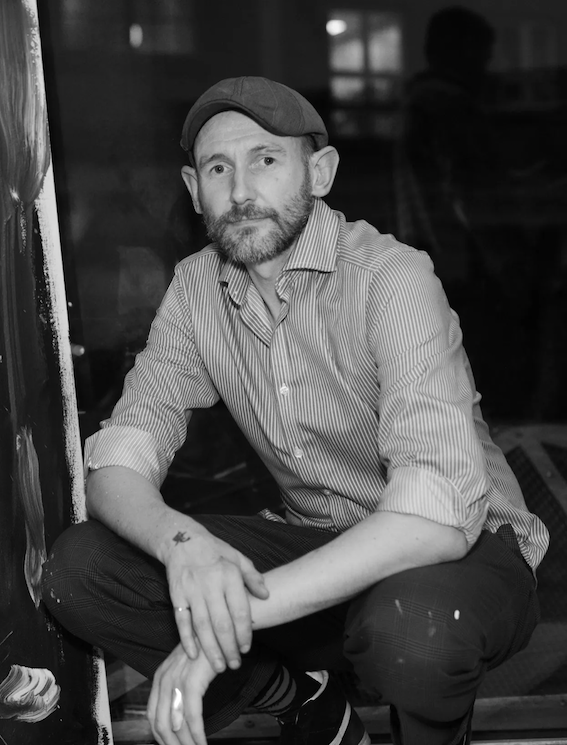
David Tovey
A fairer and juster world, one in which humanity proceeds into togetherness and with empathy—fuels the work of David Tovey, a devoted artist and compassionate human being who through his profound art and work, communicates about homelessness, shares art and helps people. Speaking on social issues, David Tovey emphasises how purpose and integrity can proceed into helping communities.
As Tovey conveys, his life journey has not been easy, illness, addictions and homelessness, had crept into his life. His achievements in art, speaking about homelessness and creating change, have been immense, though he will not dwell on his own successes or circumstances, instead he will talk about his community, pushing on with care to ensure art is available for all.
David Tovey, ex-serviceman, had joined the army as a chef. In 1997 he faced discrimination identifying as queer and left the military. He speaks though with fondness of his time in the army, and after his departure co-owned a restaurant in London.
However in 2011, Tovey sadly endured a stroke which left him with cognitive damage. He was later diagnosed with cancer and then HIV whilst enrolled in an art course. The tremendous pressures led him to become homeless and to attempt on several occasions to take his own life.
As an artist, educator and activist, David Tovey has created powerful performances and works in a range of media relating to his own experiences that have showcased and raised awareness on social issues, homelessness, loneliness, trauma and mental health.
His views of the world are one in which humanity and caring for each other transcends borders and all forms of identity.
His work, ’Unknown Soldier’ a moving performance film, comprises of Tovey recounting a soldier’s battle with mental health, PTSD and homelessness, reflecting on struggles veterans may encounter, whilst a film projected in the background combines sound and historical archive footage.
The poignant work amalgamates with the artist’s own experiences of being in the army, of homelessness, alcoholism, addiction and attempted suicide.
Funded through the Future’s Venture Foundation Radical Independent Art Fund, supporting the charity Fighting With Pride, David Tovey made ‘Unknown Soldier’ with the hope that further support be given to those that face homelessness.
‘Man on Bench Fairytale', executive produced by the Museum of Homelessness, was held at Manchester’s Mayfield Depot. The performance replicated Tovey’s last suicide attempt on a bench in a park, which he thankfully survived when Gavin, a park enforcement officer stopped to speak to him, provide food and take Tovey to a shelter.
The staging which included operatic elements, also relayed about Tovey’s brain injury, depression and HIV+ status, challenging perceptions and unfair invisibility, featuring models, poets, actors, musicians—volunteers that had experienced or are still experiencing homelessness. Fashion and textile work was used as a tool to relay important notions, a tool Tovey had also first utilised in ‘Man on Bench’—the outdoor fashion show on Southbank. The 'Man on Bench' series named after Gavin, have taken place through different formats, on the pavement of London's Southbank, The Mayfield Depot Manchester and as part of The State of the Nation Tate Exchange, Tate Modern.
David Tovey's art has been exhibited at the Atsa Festival Montreal, Kunsthall Stavern Norway, Tate Modern and Tate Liverpool, where his installation ‘A Soldiers Story’ depicted the stories of homeless veterans, unwrapping the struggles they are confronted with upon leaving the armed forces.
Tovey’s paintings and photography are an expression of emotion. His body of work communicates, highlights and spreads the message of dignity, humanity, equality, and care.
As co-director of Arts & Homelessness International, Tovey aims to bring to light homelessness, push for policy change, strengthen the arts as a connector for the homeless community, ensuring there is access to art for all, and that trauma, mental health, addiction, isolation are spoken about.
In conversation with David Tovey, our discussion comprised of his life journey, his thoughts, art and work. Authentic, dedicated and passionate, artworks filled with depth, David Tovey shares with us his significant and moving testimony of his life experiences, the power of the arts he has felt, and wants to share, his commitment to helping his community and implementing new policy in regards to social issues and homelessness, and his thoughts on politics. Our talk started with the artist recalling his childhood and what led him to art….
Coming from a poor family, we couldn’t afford to buy stuff, and I quickly sort of learnt how to fix things; I used to get a hold of my brother’s toys, take them apart and create something new. I always felt different, trying to build something unlike what was expected; I never really felt like I fit in anywhere.
I feel like community is needed, because without it, I think we get lost. That’s what happened to me for many years, until I found the community I live with now. I struggled for several years and that isolation had just brought about other problems.
We all need someone to talk to who can understand us. If you haven’t got that, trust me it’s really very difficult.
I think it’s because i’m stubborn I got through it. I get really wound up when people tell others they can’t do stuff or shouldn’t do it, because “we’re not supposed to do that”—it’s like why? Why aren’t we?
We are all human beings. I’m for open borders, we don’t learn by being siloed in a hole from other people.
I guess in a way, when it comes to my art, I’m a protest artist, or as I usually say, a social justice artist. Ultimately, it’s me protesting about the world that I live in, and I don’t have the best way to explain things because of my brain damage.
Though that’s what has also charged my art; when you have gone through a traumatic time and have doctors telling you, ‘oh well, you will never work again in your life’, then I just thought, I’m not a piece of glass that needs wrapping up in cotton wool, I am a human being that has just gone through a little bit of a blip in life. That’s how I always look at it, because it’s only a small part of who I am.
Illness, homelessness and addiction, they shouldn’t define who you are. But we tend to let the world define us by things like that.
Yes I was struggling to do stuff because of the brain damage from my stroke (in 2011), but as soon as I figured out that I can use another part of my brain, I used creativity in a way to get out of a really bad time. That’s how I started.
I never thought I would get to do an exhibition, let alone be doing what I am doing now, in regards to policy and homelessness; it’s been quite surreal.
In 2012, I went to university, I’d always been creative but never had any art training, so I thought after my stroke, I would give it a go, but I became so unwell that I had to pull out.
I lost my house, I was living on the streets; and trying to do a university course was just impossible. Nevertheless, I said to myself, I’ll carry on making art, and that’s what I did.
Art doesn't make me much money, though some may think otherwise.
The payment structure in the creative industries is not always just. It shouldn't be like that.
Yes it shouldn’t be. But to be honest, I don’t have much regard for money—it's what destroyed me in the first place. When I started making art, I wished for it to be as accessible as possible; for ‘Man on Bench Fairytale’, I didn't want a single person coming to pay, whether they were super rich or whether they were a homeless person; how can I do a show about homelessness, about trying to take my own life and say to people, you’ve got to pay to come in—no, that’s not fair.
Many were quite shocked about that; but there are so many people who should be going to see art who aren’t enjoying it because they can’t afford it, and that really winds me up. That’s probably the thing that keeps my mind focused on my job.
I have my art career, but I also have my career as a director with Arts & Homelessness International (AHI). That side of me is going into cultural spaces, stating the need for art institutions to open up to a wider audience.
I never get why cultural spaces say that they don’t understand why working class people don’t visit enough their establishments. What do they expect if tickets are expensive. The arts are still aimed for a certain type of person and it shouldn’t be like that.
I love going to galleries, museums and theatres, I go as much as I can, I take my mum, she's on a pension; an art day out shouldn't be so costly.
And refugee families should have opportunities to have access to the arts, to go to the theatre. Instead they are placed in a detention center. I can’t stand that. I get irate about things like that, but I can’t tell their story, I can tell my own, because I have lived experience of my story.
The arts can document history, but it’s mostly been from one side. If you think of women artists, who if anything were better than their male counterparts, they haven’t always been acknowledged, and that’s often still the case, which is fundamentally wrong. We have to create change, both in our political system, because the capitalistic approach doesn’t seem to work for most, it works for a small few, and in how the arts system currently functions, because it's still only a select few that get through.
Don’t get me wrong, within my own art work I don’t mind being on the outside of the art world, I actually like that, because in a way it gives me a bit more freedom to talk about what I want. Some artists have to put out work that galleries think audiences might like.
Art as a commodity
I guess then artworks become assets.
That’s fine, people need to live; if art is all someone wants to do, then that has to be funded. And there isn’t enough funding out there. To write a funding application all day long, I didn’t see that as a sustainable model of work, so I carried on having a job, and then created my artworks with my wages.
I do get funding every now and then, but my brain damage doesn’t always allow me to constantly do the paperwork, so I often go for ones that are viable.
There are great organisations like Unlimited who are making a massive difference, where one can apply via video or audio. They are focused on helping artists who don't usually get funding. They were the first to fund me and I’m really lucky to be one of their trustees now.
Some of the works that you have done, like 'Unknown Soldier’, you evoke the struggles that ex-service personnel have encountered, is there a better support system now?
I lost my job in 1997 because I was queer; at the time there wasn’t any help. We weren’t even allowed to access the military charities.
Trying to get my head around my journey was very difficult because as soon as I left the military, I got into trouble with the law, and went to jail.
When you are trying to figure yourself out, and then suddenly you have your job taken away from you, you tend to isolate yourself, and sadly, I isolated myself for far too many years and didn’t tell people what I was going through. As soon as someone had an incline, I would leave, runaway, all the time. That can only last for so long—until 2011, when I had my stroke, and life started to turn for the worse. But that’s also when I decided I’ve got to really deal with this.
Now there is a lot of help out there, for homelessness too—predominantly, a lot of homeless people are ex-forces, because of trauma problems. Veterans are very proud people, they won’t ask for help; they always feel like, 'got myself in this situation, i’ll get myself out', and that’s how I was as well.
I always thought life isn’t supposed to be easy; at some points, it’s supposed to be a struggle; but I don’t think it’s supposed to be as much of a struggle as I have had it, with all my illnesses and everything that has happened, a lot of people would not have gotten through it, I’m surprised that I have—I didn’t think I would—there were several times were I tried to end my life.
Thank goodness you didn’t
It’s 10 years since my last attempt, since I met Gavin in the park who saved my life, whom ‘Man on Bench’ is named after.
I actually went back to the park the other night. I was in the area and thought, I’ll just walk passed and see what it’s like. It triggered me; it was really weird because as I arrived, the gates were open, exactly the same as they were the night I tried to kill myself; it was dark, it was surreal.
I took a couple of photos of the gate, and I must have been shaking because when I arrived home, they were all completely blurred; they are stunning, but it was strange; I’m still trying to get closure from that whole event.
That’s why my works ‘Unknown Soldier’ and 'Man on Bench Fairytale' , have this underlining similarity to them, because the fact is, it’s the same story done in completely different ways.
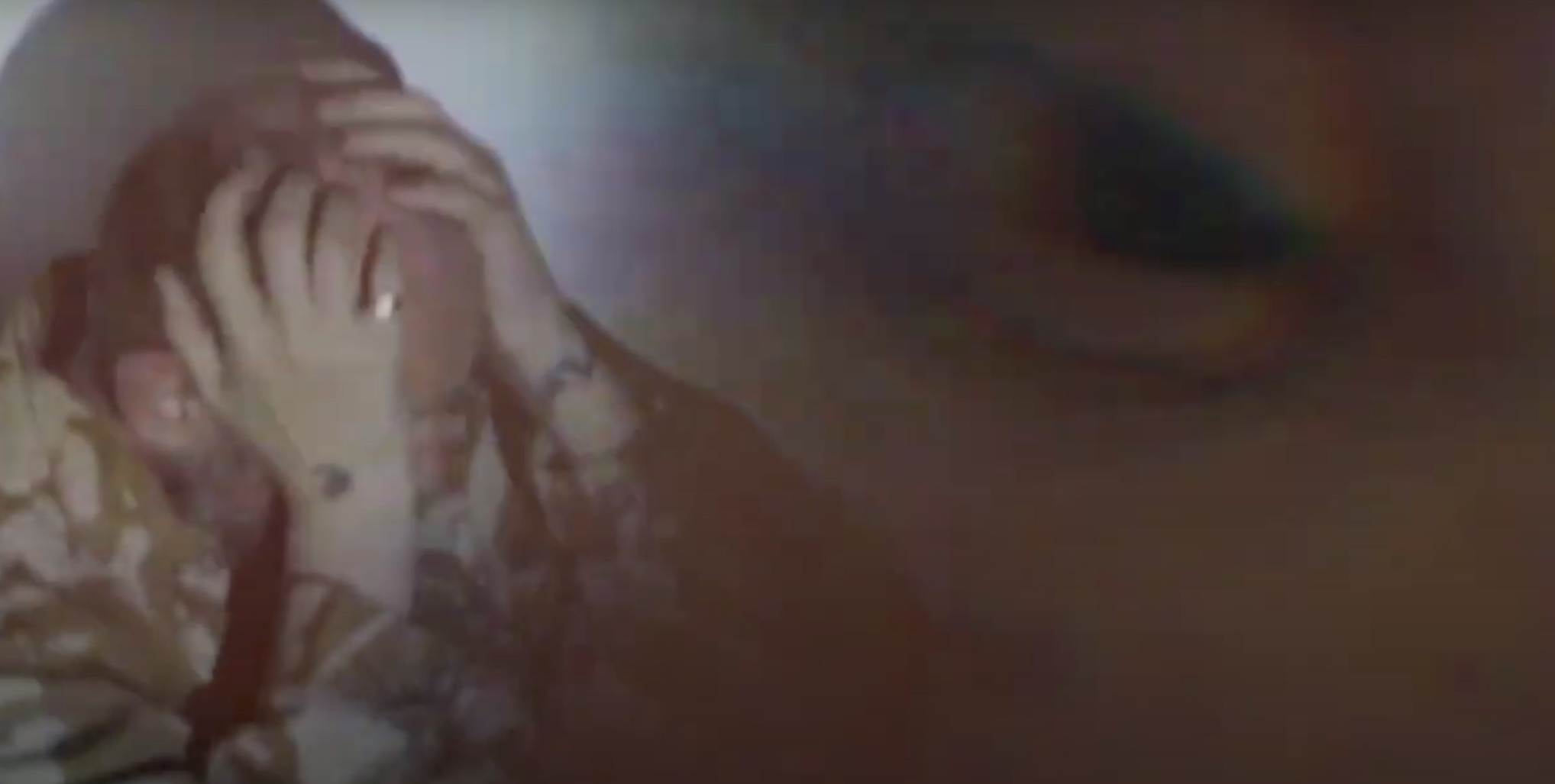
Film Still from Performance Film 'Unknown Soldier' by David Tovey on World Homeless Day 10/10/2020
’Unknown Soldier’ comprises of Tovey recounting a soldier’s battle with mental health, PTSD and homelessness, whilst a film in the background combines sound and historical archive footage. Relaying the life of a soldier, reflecting on struggles veterans may encounter, amalgamating with the artist’s own experiences of being in the army, of homelessness, alcoholism, addiction and attempted suicide.
Funded through the Future’s Venture Foundation Radical Independent Art Fund Artist and supporting the charity Fighting With Pride.
‘Man on Bench Fairytale’ —(following 'Man on Bench'), is a spectacular staging, of which Katy Rubin who used to run Theatre of the Oppressed in New York, told me, that she thought it was like a f*cked up nightmare of a dream; and I really liked that, because that’s exactly what it was, what it felt like every time these things were happening to me, it felt like I was dreaming, that this couldn’t be real.
The staging was incredible, we were about 120 performers who took over Mayfield Depot in Manchester. I moved in vehicles, there was a bus, a real life actual ambulance, paramedics,—it went beyond and took a lot of energy out of me. During the performance, I was lying on the bare concrete floor with half my clothes cut off, as it was cold, I started to get hyperthermia. The audience were sat on the floor because I wanted them to feel what homelessness would be like, but we supplied them with blankets and silver foil blankets, as well as them being fully clothed.
The whole show was really emotional for me, because it was so autobiographical, and I was actually the person playing me, which is something I didn’t originally want to do, but the actor had to pull out, so I had to do it, even though I’d never acted before; which meant I had to relive it—instead of acting, I relived my experience.
The morning of that performance I couldn’t speak to anyone; if I did, I cried, I just couldn’t hold it together. We were so close to cancelling because my mental state was literally just about to break. Yet I knew if we had, it would destroy me, I truly felt that, as so much had gone into that show.
I thought of the thirteen months it took to put it together, of the people who were doing the workshops with me, and I wasn’t willing to fail, so I didn’t care how much the performance was affecting me, because I wanted everyone involved to feel great—it was their show too. I saw people who had never sewn before making costumes and performing in the show, it was just beautiful.

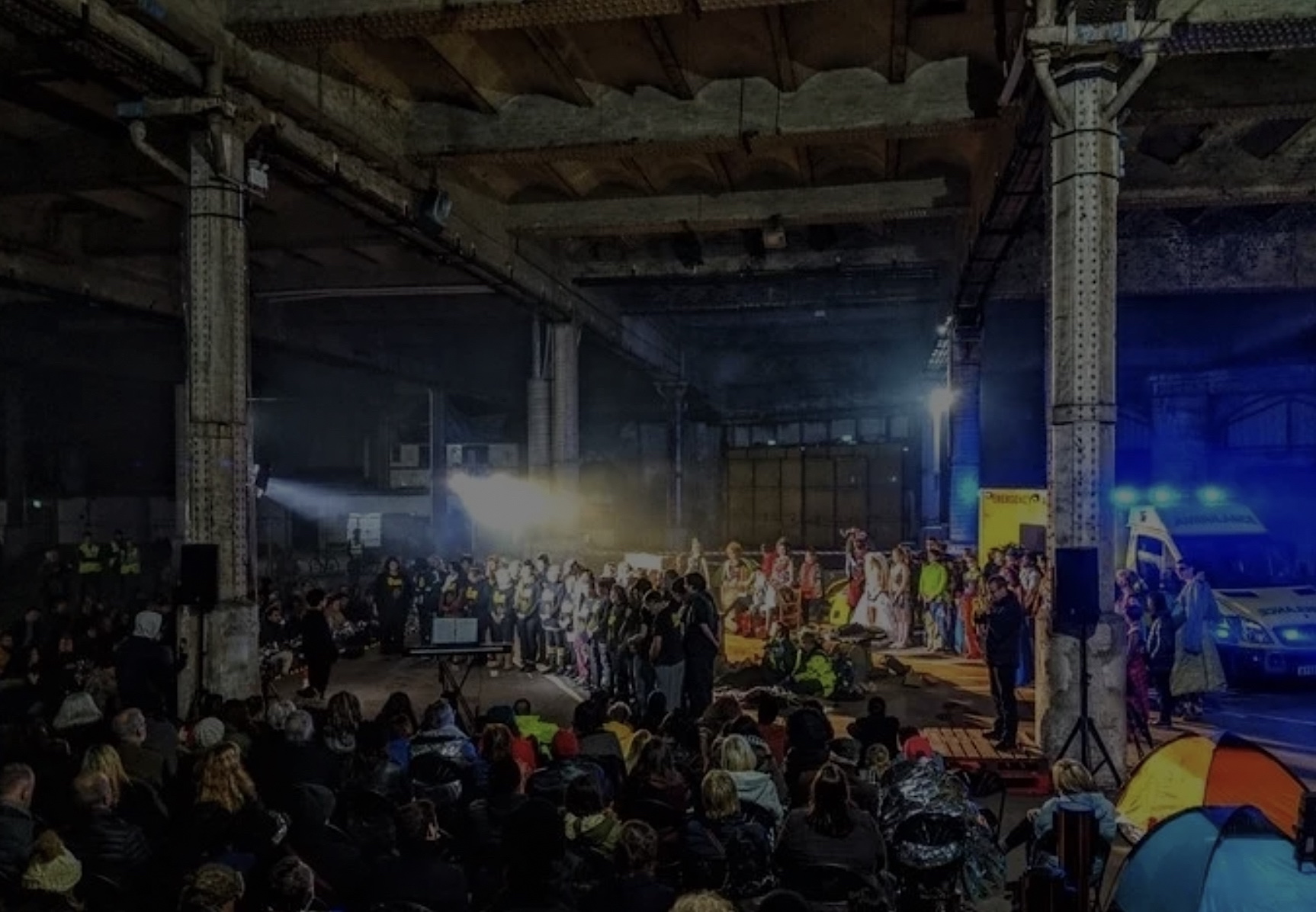
Man on Bench Fairytale at the Mayfield Depot in Manchester by David Tovey, Executive Producers by the Museum of Homelessness, 18/11/2018
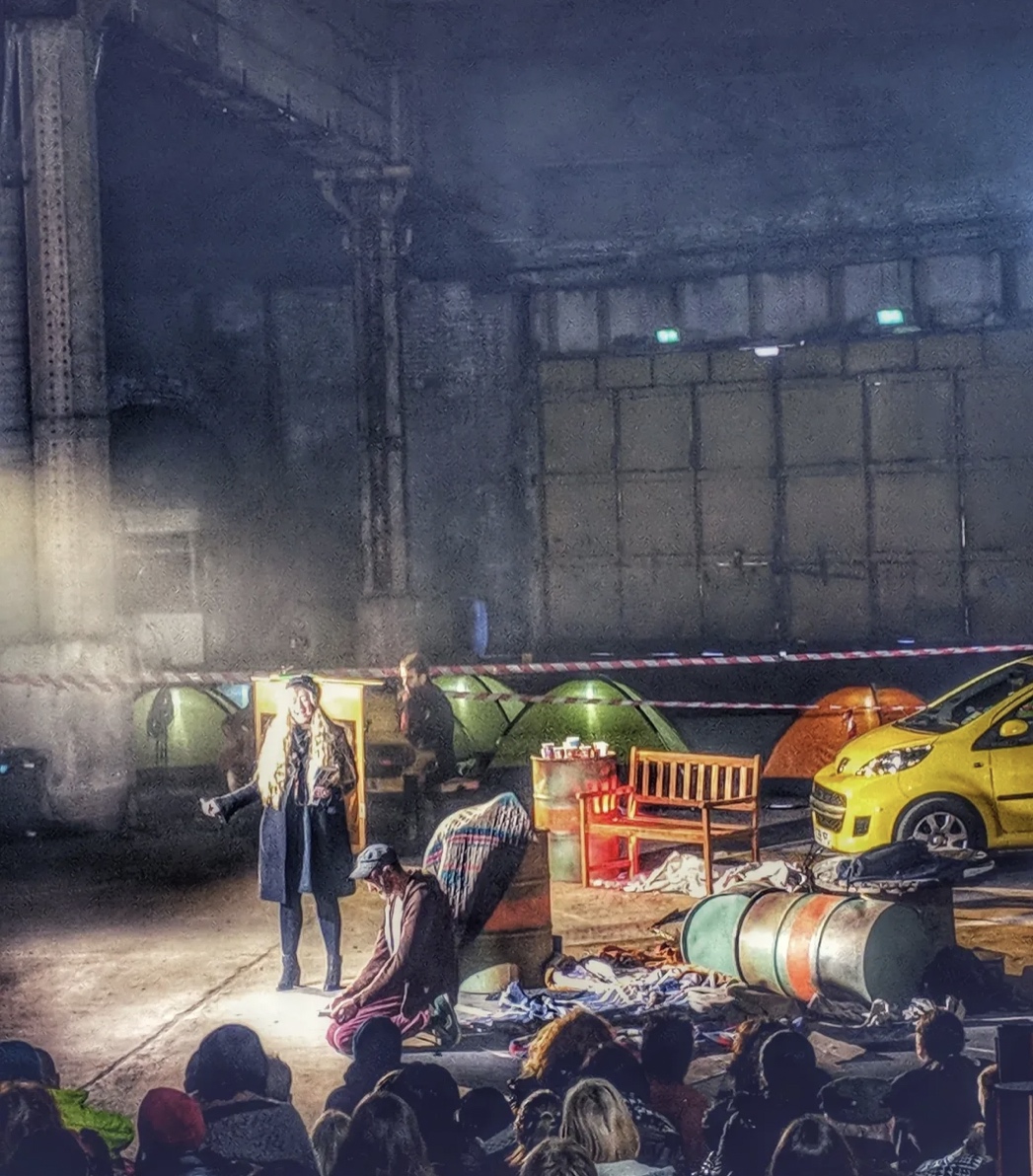
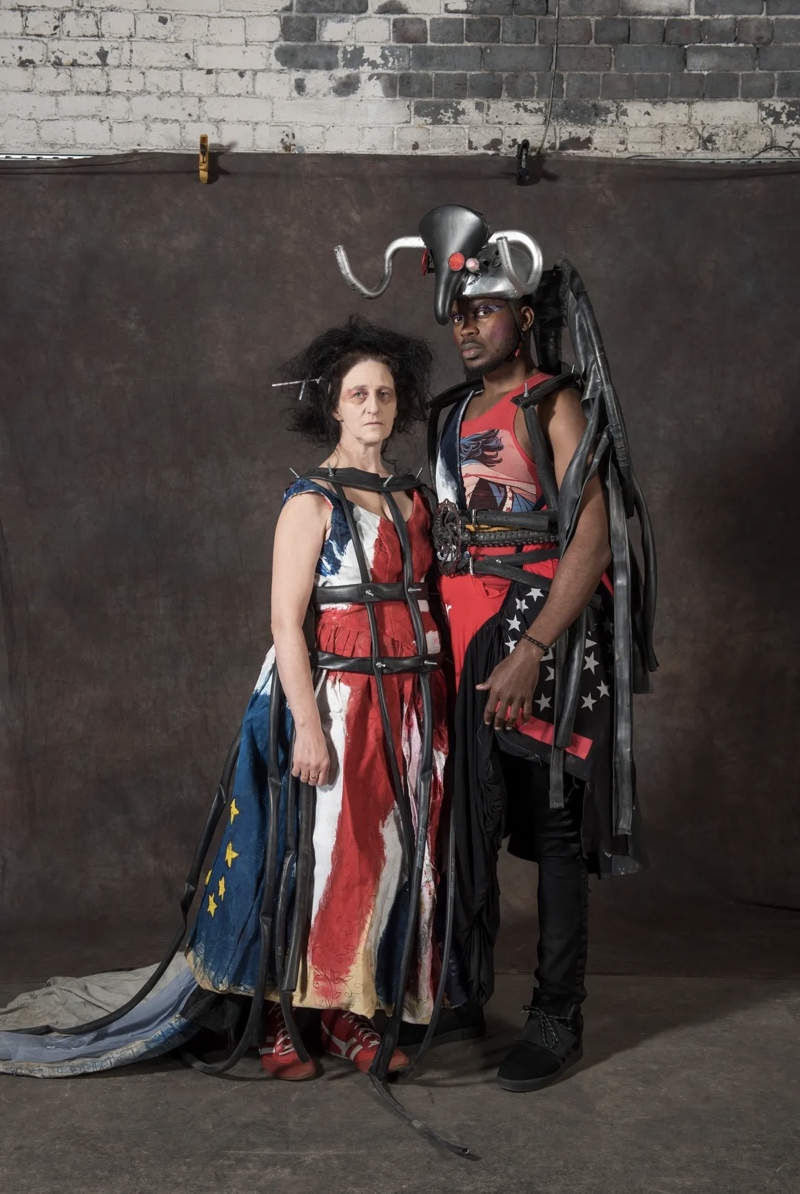
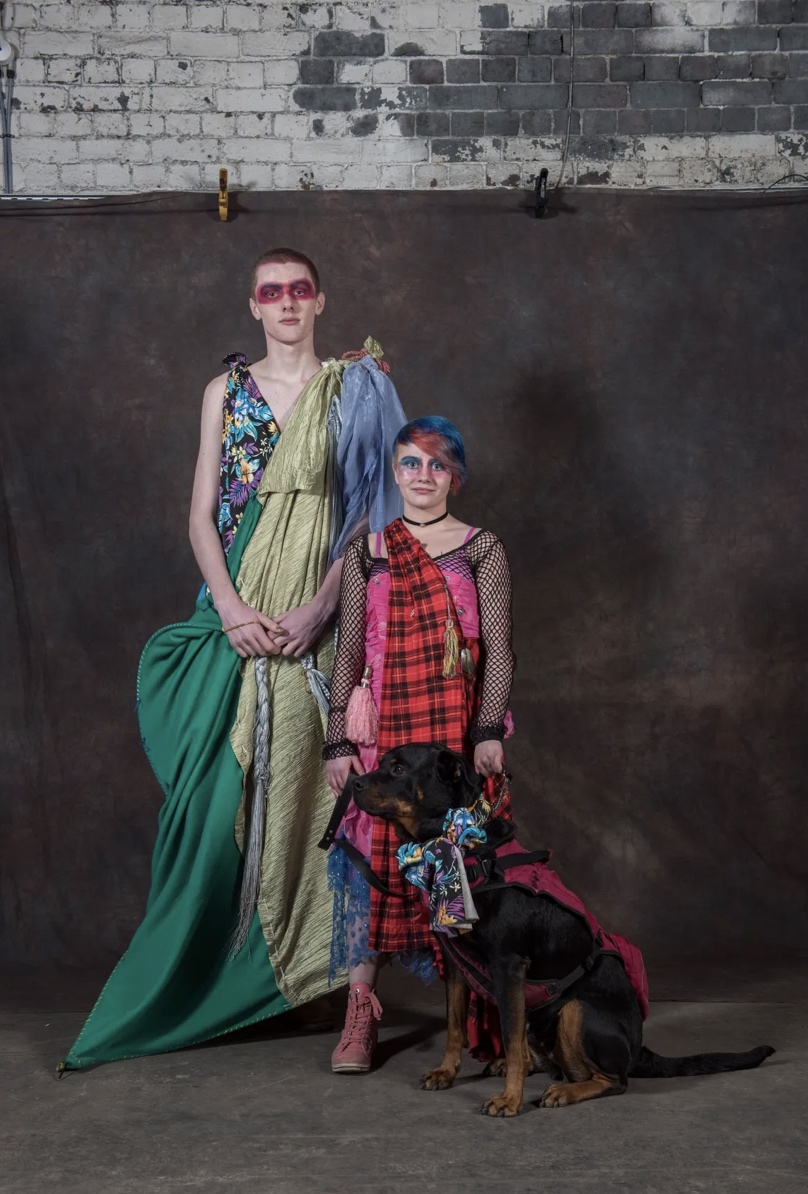
There is much use of clothing in your work, fashion elements, army clothing, how do you utilise this approach to convey your message?
My main medium is photography, that’s what I went to university to study, yet for a while now, I haven't really put on a photography exhibition. I got to the point where I was struggling to tell the story that I wanted to tell through photography, so I decided to do something different.
I was asked to design a t-shirt which in the end was never sold; It was a sketch of a bus and on the back of it, a list of all the places where I used to sleep rough. I asked how the t-shirt would be promoted, and found it a bit boring that it would be online, so I suggested a fashion show during London Fashion Week. The idea was liked, but we couldn’t get anyone with a fashion connection to get on board, nobody wanted to help. I found it really weird because, you know, homelessness is a big deal, we should all be worried about it.
We couldn’t even get a venue to help us out. When that happened, I said let’s just do it ourselves. So one Sunday afternoon, we decided to take it to the streets. Those in the show all got changed in a hotel, and then they walked down to a little wooden pier which became our catwalk. That one performance, 'Man on Bench'—Performance at Southbank, River Thames in September 2015 completely changed everything.
In what way?
Because we were seen.
I was asked what it was all about, I replied—it’s the story of homelessness. Yet the querier couldn’t see any homelessness, and that was exactly the point—I spoke about it through fashion, taking old materials, bits of rubbish that I had found on the street and turned them into pieces that people could wear. It was about showing that if we can do that, turn rubbish into wearable functional clothing, then we can do the same with the system that propels homelessness, we can provide people with support and help. It’s that simple, that’s all it was.
The person I was speaking to, just happened to be the Deputy Arts Editor of The Economist, who coincidently had been out that day walking in the same area of our show. I recorded a blog with him about our work, it went viral, and was noticed by The Museum of Homelessness, who then helped reproduce the fashion show at the Tate Modern.

'Man on Bench' Performance presented by Museum of Homelessness as part of The State of the Nation Tate Exchange, Tate Modern London 09/04/2017
‘A Soldiers Story’, which is one of my proudest pieces of work, was also at Tate Modern, and on display at Tate Liverpool.
That particular work informed the piece 'An Identity Tied to Conflict'.
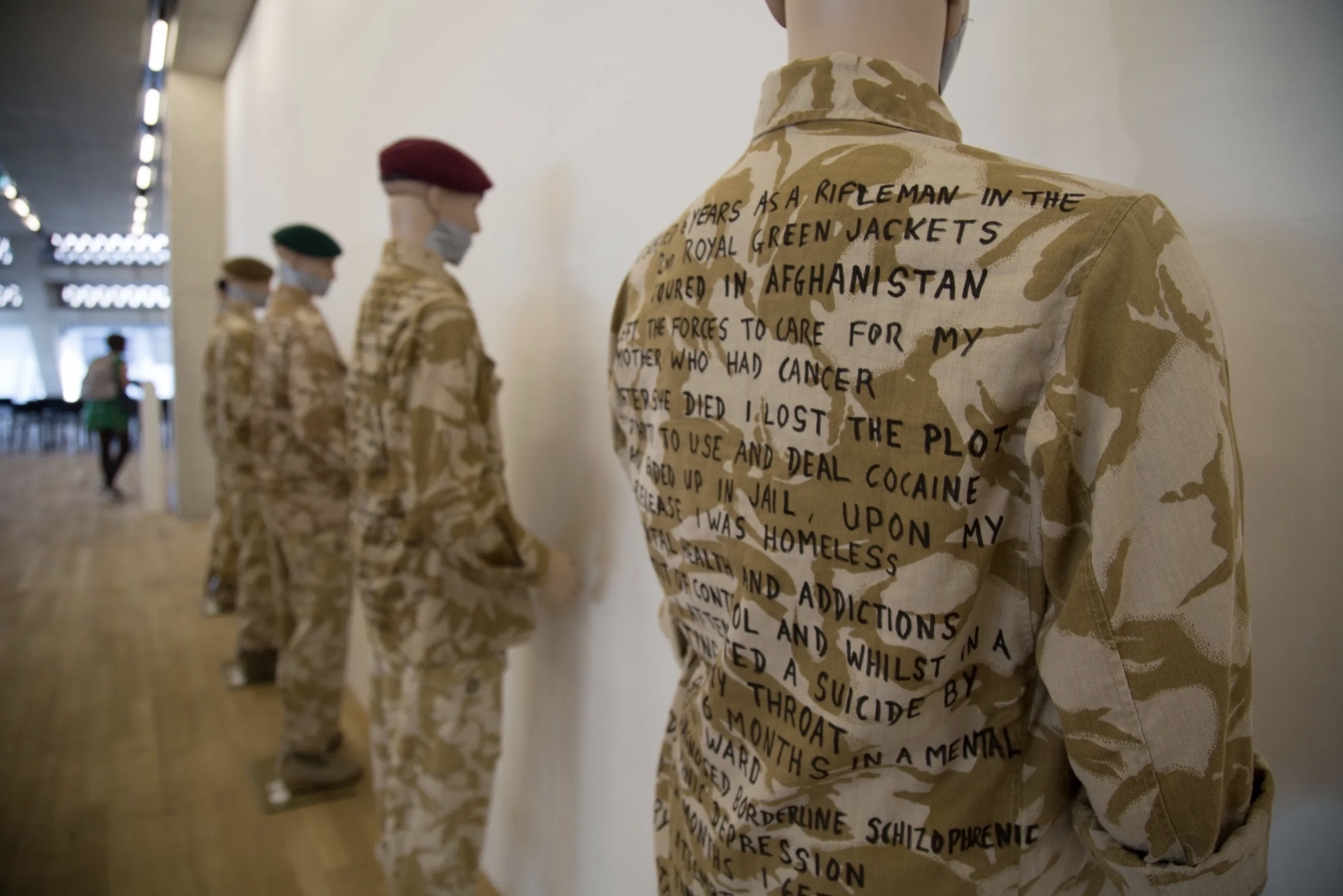
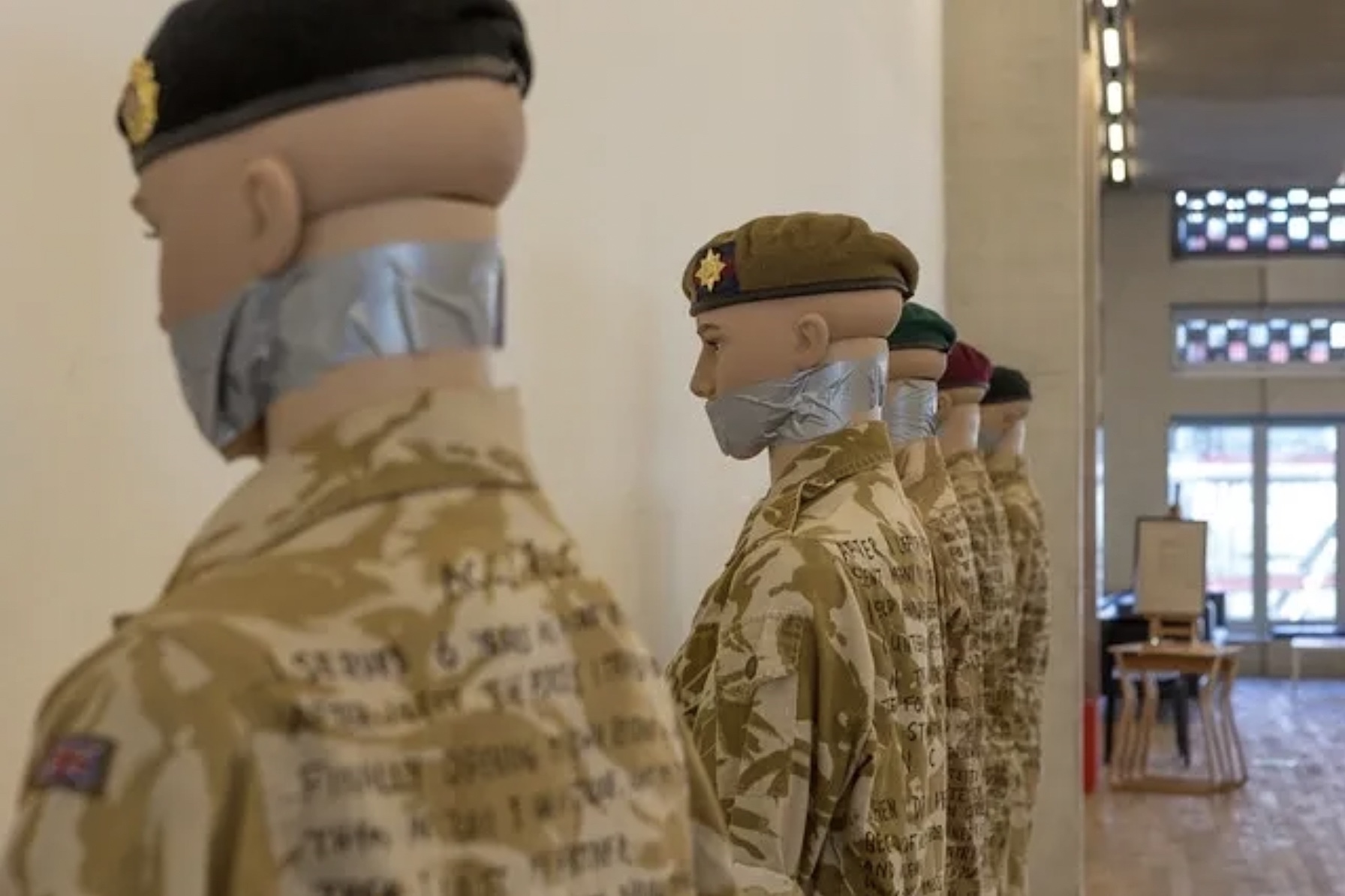
'A Soldiers Story' Installation and workshop by David Tovey, presented by Museum of Homelessness as part of The State of the Nation, Tate Exchange, Tate Liverpool 22-28th January 2018
'An Identity Tied to Conflict' is a sound recording where over a 6 months period I worked with US Veterans. Each week, I would open up an online space for them, to chat about how their week went and give them a little task to do. We ended up creating a unique sound piece. I worked on the project with a good friend and the world famous producer Laima Leyton. The recording is heartfelt. Some veterans from the project revealed to me that they had shared things they were unable to with their families, but that now they could.
The change that I see when people are actually given access to use art, to change their lives through it, is amazing. I watch it all, I think wow, and I can’t believe it. That’s important to me.
Did you ever do any art whilst you were in the army? or did that come after?
Not really. I did before joining the army, because my mum used to teach me everything, and so most of my drawing skills come from her.
I think that side of things are always on the back burner when you are in the army, I was working long hours in the kitchen. But throughout my military experience, I used to appreciate art and listen to music.
Art can be therapeutic
The other weekend, my mental health was really playing up and I wrote several pieces which I think will possibly go into one of my new shows.
It was very powerful, and sometimes you have to use that material, that illness, that awful time in life, to be able to understand yourself, and I truly think, that if it wasn’t for the arts then I would be dead.
Art gave me an avenue to have everything played out. That's probably the best way to put it for me, It was about getting that pain out of me.
You get to a stage in life, where you can no longer deal with things, and there are several ways that can go, one of which is putting that energy, that anger into something like the arts. Don’t get me wrong, not everyone can do that, I know that, I’m just very lucky that I had the opportunity to be creative.
I’m not better than anybody else. I believe in equity, I want the world to be completely equitable. If it will ever be, is another thing, probably not, but I will try.
You started The One Festival of Homeless Arts?
That’s been quite special to me, I’m super proud of it. It was not easy to start, at the time I was on a disability benefit.
I stepped down last year due to my health, however the venue where we held the festival, said they wanted to carry it on, which is brilliant, I handed it over to the community, and that’s all I ever wanted. It’s now known as The One Roof Festival. I get to go and enjoy it and even do a couple of workshops.


The One Festival of Homeless Arts, now known as The One Roof Festival, brings together works of art all of which have been created by artists who are or have been homeless.
Can you tell us more about being the co-director of Arts & Homelessness International?
That’s a charity where we advocate for arts to be part of a support structure for people to get out of homelessness.
I would say the arts can’t give you a house, but it can give you a pathway to one.
What it does, and I see this when I do workshops with homeless centres, is that, someone can go from being the most chaotic person in the world, but with some pens, papers, access to paints, or charcoal, they can become themselves again; art calms.
Katie from AHI and myself go into cultural spaces and train people how to work with our community. We do that in several ways, from one hour sessions to a full day. We are noticing it is having an impact and are being contacted by cultural spaces from around the country and beyond. Katie was lucky to travel to Brazil and train 300 people from cultural venues.
In the UK, Rochester has a huge art scene but what they don’t have is access for the homeless communities to be creative. So we are now helping build an art infrastructure and have been working with the council on that. The town has set up an arts and homelessness forum which I’ve helped with, and which in-itself will open up opportunities for the community over there. Great changes are happening.
Is that a policy you would want to see implemented?
If you could get that in every town across the country, yes totally.
I disagree with homeless charities who are cutting their educational and arts programmes. The charities who do that, seem to think that homelessness is all about housing, but it’s not just about that, because we know that there are enough empty houses in the UK for every single homeless person. It’s all the other things, like rent, a marriage break-up, mental health, all of it, there are a multitude of reasons; and so, when someone becomes homeless you have to have a multitude of solutions, you can’t just have one answer that fixes all; it doesn’t work like that.
I would love for the government to endorse the arts within any program development for homelessness, because it’s a human right, it has to be available.
It's Article 27 (of the Universal Declarations of Human Rights)—and if you are having those rights taken away from you, then there's something wrong.
We have to stand up for those who can’t fight, I may not always get my words out in the right way, but i’m not scared of losing everything as I lost that years ago. I know what it’s like. From family, friends, my house, business, everything, I lost all that over night. To lose all that and then pick yourself up again is really really hard. But if you do, then…
If more companies started employing people with lived experience, homelessness, mental health, and experiences like that, then I think they would become a better company, with more depth and understanding.
Homeless people are the best networkers and marketers in the world, they have extraordinary resilience. Sitting on the streets all day long, with thousands of people walking past, some hurling abuse, spitting or throwing things at them, even shouting out, get a job you lazy so and so, it would get most people down. But they are there the following day, because they have to survive. If a person can get through that, through addiction, mental health, and find themselves back into living in what is seen as the ‘norm’ whatever that means, then that’s like moving a mountain. They are superhuman. I see it on a daily basis, those who come to my art classes, starting off with addictions or restlessness, to going to university and really thriving in life. It makes me proud that I was a tiny part of their journey, and to be able to call them friends, is just beautiful; but people don’t see that.
So it’s the power of art and it’s also compassion and care that we show each other as human beings
It’s also respect. We have to show each other respect, instead of demonising each other.
I would be proud to put on my CV that I was homeless. I call myself an ex-homeless artist, I’m not ashamed of that. That’s my super power, it has given me what I’ve got, how can I then turn my back on it.
I hear things like, we are going to eradicate homelessness, I find that type of terminology disturbing. That rhetoric always makes things worst, because it focuses on the wrong part, instead we should hear how to make life a little bit easier for those people who are sleeping rough. Like why is it so difficult to be able to get a shower, to get clothing, a sandwich, somewhere to sleep.
My friend made the video that went viral of the homeless guys having their tents crushed and being arrested because they had their tents out.
More empathy and humanity at the forefront should be embedded within the framework of politics and policy
Definitely. It’s about understanding. The problem is, at any time throughout history, not all, but most ministers don't have lived experience in the field they are nominated into.
During Remembrance Weekend, I was lucky enough to speak to the Prime Minister about policy and homelessness. Such as with the hostel system, which actually entraps people; a homeless person is only allowed to stay in a hostel for two years, after that, the system moves them out to another hostel rather than help them out of homelessness. No schemes, no training programmes, nothing out there, there’s no incentive for a homeless person; and if they have problems, like mental health issues, then they will carry on having them. There has to be a supportive policy.
The Jigsaw of Homeless Support, from Arts and Homelessness International, is part of local government homelessness strategies and strategies for homeless charities. It explores what a human being would need to function in life. We have arts and culture within the model, because without them, a person can’t function. I would say it’s better to stimulate your mind with the arts than with substances. People on the streets, are often reading books, sketching on the floor, which proves you need art and culture, it is something to do.
We will descent in an Orwellian world, if we don’t have arts and culture.
If anyone wants to help, where can we go, what can we do?
My biggest advice is to never walk past a homeless person or look down on them. And if you are going to have a talk, why not sit down with them, be on the same level.
Stopping and having a chat with someone, it’s the biggest thing. People don’t talk to the homeless because they are scared of what to say. Homeless people are already upset, don’t worry about it, just chat.
That saved my life 10 years ago, I was killing myself on a park bench, if it wasn’t for Gavin stopping and asking me what I was doing, then I wouldn’t be alive. Those small interventions can be life changing for homeless people, because suddenly they are being acknowledge.
Don’t get me wrong, they might tell you to go away, but at least you’ve tried.
I always say wouldn’t it be nice if people didn’t judge others for things from their past or for having a criminal record. I still have massive barriers for having one. That’s where organisations like AHI try to be a route around some of those barriers.
The very first AHI Awards has taken place. We had a lot of people apply, pretty much from every continent around the world, which was fantastic. We also held a Middle East Festival, someone spoke from the Gaza Strip, it was very powerful and important that we hear from them.
I was supposed to do a performance in Rochester, I couldn’t do it in the end, because I got triggered by the War in Ukraine and now in the Middle East, it’s a lot for me mentally to deal with.
I don’t understand—and i’ve been to war—why war has ever been an option; not a single person wins. No one wins.
And there’s more love out there then not.
We are all connected. Art can help with that. Your art and work is, alongside highlighting social issues
I’m currently working on a piece about addiction, explaining it in a different way. How in certain circumstances, it can be about survival, and I know that sounds awful, and perhaps many may not understand, but when my life was going through hell, it became a reason to stay alive. I’m working on that piece and a very big band from America will be part of the performance installation.
And I will be working with 8 schools around the UK, to build a structure looking at hidden homelessness and children in homelessness. All the pupils from the project will have their art put up in an exhibition, and we will build a massive participatory structure from their artworks which hopefully will tour the UK.
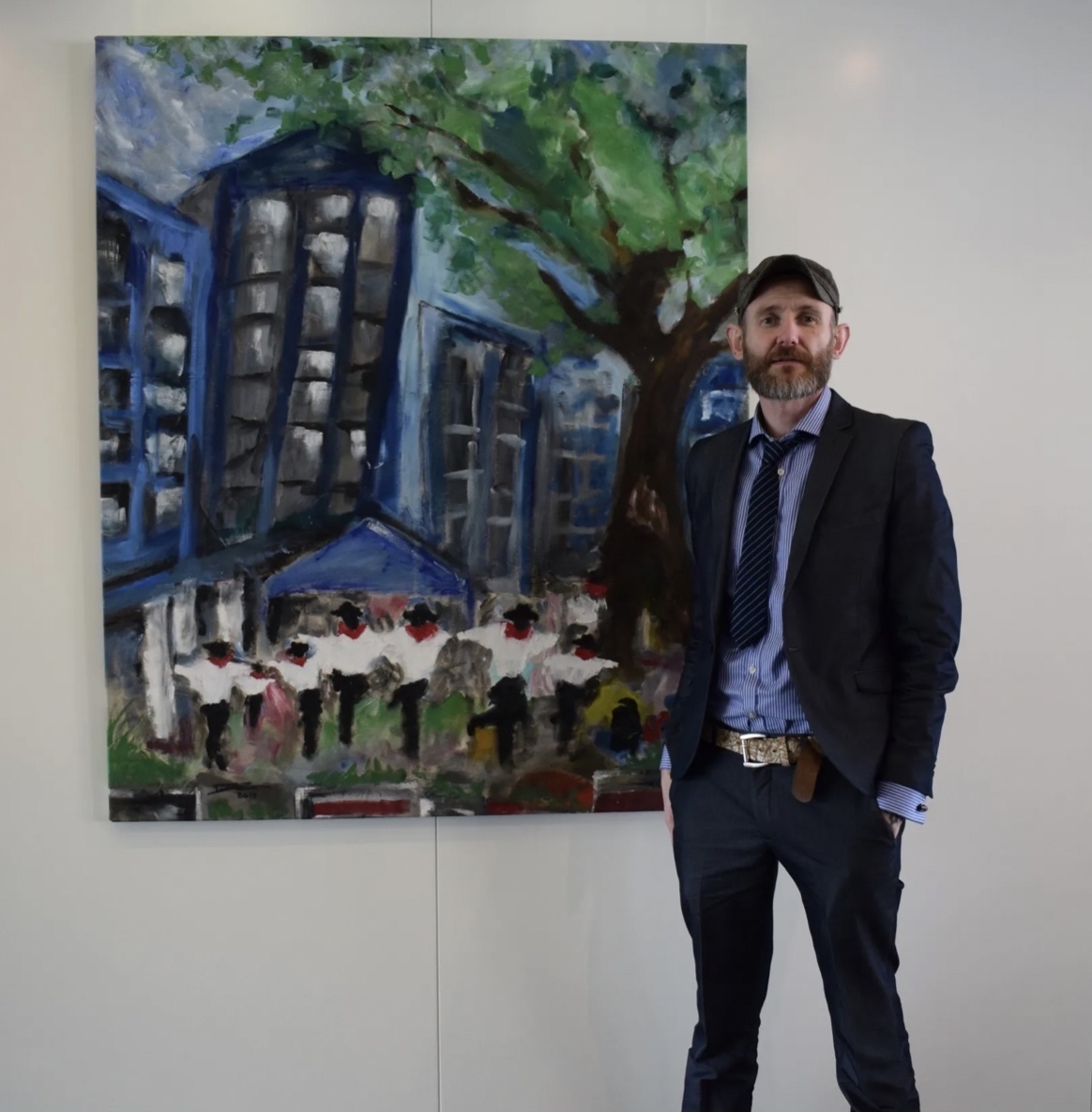
.jpg)

Gavin painted by David Tovey
David Tovey is an Internationally award winning artist, educator and activist who works in a range of media. He is a photographer, painter as well as an installation artist and performance-maker. At the heart of David's practice is raising awareness about the social issues he tackles. David has exhibited internationally in locations such as the Atsa Festival Montreal, Kunsthall Stavern Norway, Tate Modern and Tate Liverpool and he is also the founder of the UK’s first One Festival of Homeless Arts, known today as One Roof: Festival of Homeless Arts. He speaks regularly at housing and homelessness events and teaches art to people experiencing homelessness at Passage House. His Man on Bench performances have earned him significant acclaim and have taken place on the pavement of the London's Southbank, The Mayfield Depot Manchester and the halls of Tate Exchange.
David is Co-Director at Arts & Homelessness International. Is the Patron of The Gem Programme, Is a Trustee at Unlimited, a Big Issue Change maker 2019 and a Core group member of the Museum of Homelessness.
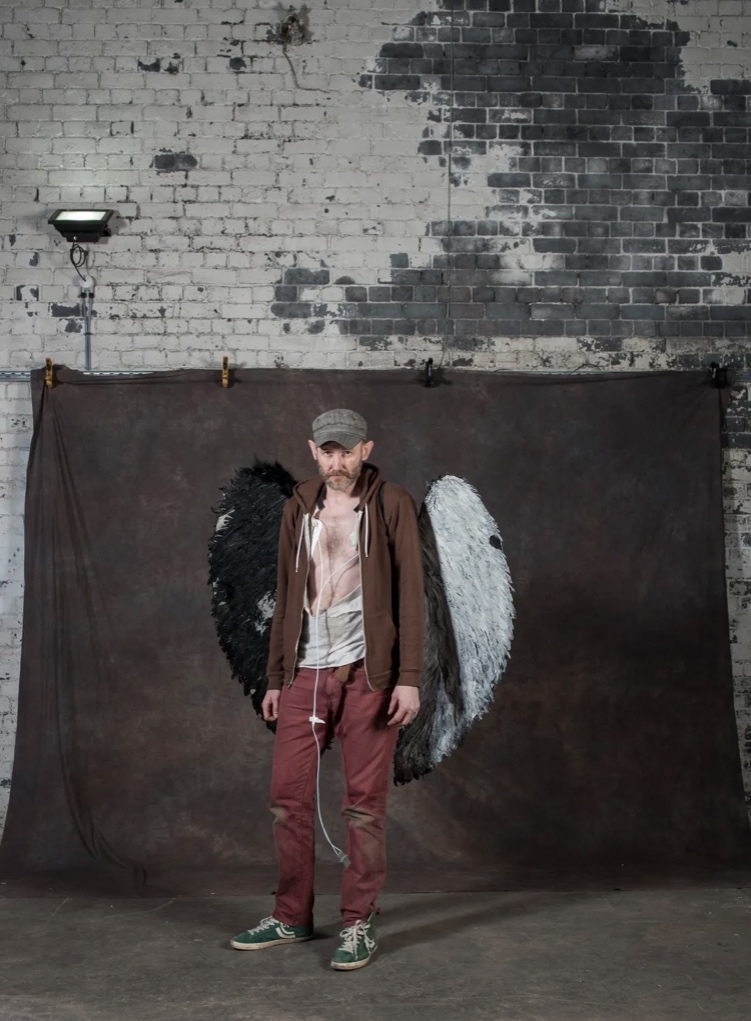
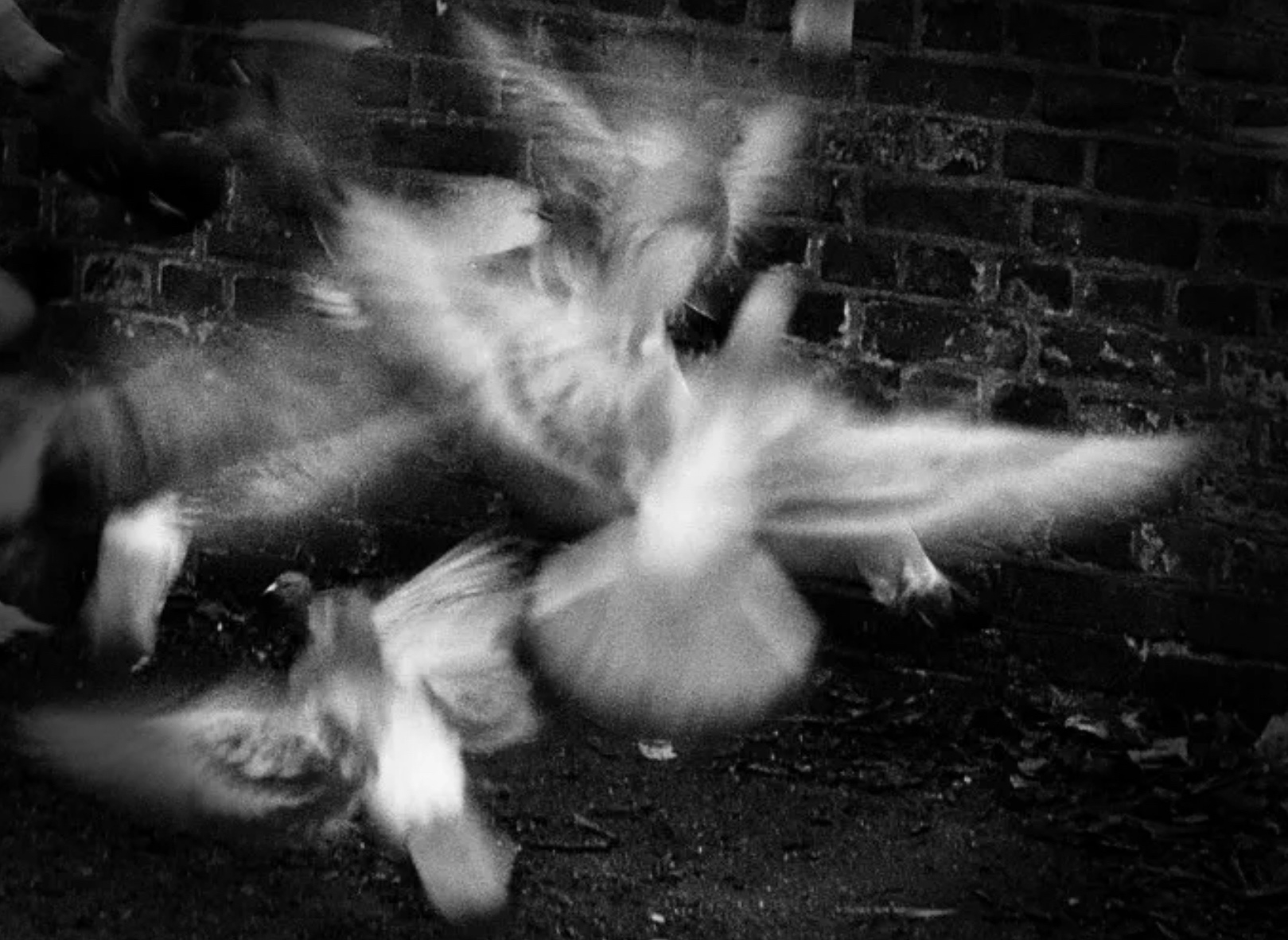
Photography by David Tovey
All pictures courtesy and copyright of David Tovey
https://davidtoveyart.co.uk/home
